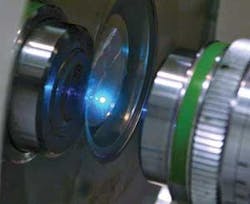Just after researchers at Norfolk State University (Norfolk, VA), Purdue University (Purdue, IN), and Cornell University (Ithaca, NY) announced a tiny laser fabricated from a 44-nm-diameter “Cornell dot” with a gold core and dye-doped silica shell, researchers at the University of California at Berkeley (Berkeley, CA) announced a laser with a 5 × 30 nm lasing region.
The Cornell dot laser works by using a pump laser to excite dye molecules. The molecules release energy to generate surface plasmons—free electrons at an optical frequency—that in turn trigger more molecules to release their energy to create a spaser (surface plasmon amplification by stimulated emission of radiation). Out-coupling of the surface plasmon oscillation to photonic modes produces photon emission at 531 nm corresponding to resonance in the 14-nm-diameter gold core. Contact Mikhail Noginov at [email protected].
Like the Cornell laser, the Berkeley laser also depends on surface plasmons. However, lasing occurs in a structure consisting of a cadmium sulfide nanowire with a silver surface separated by an insulating gap of only 5 nm. The nanowire acts as both a confining mechanism and an amplifier; when pumped at 405 nm, emission is observed at 489 nm (see figure). The researchers eventually hope to shrink the lasing cavity to 1 nm (the wavelength of an electron), opening up new applications in molecular probing, faster communications, and quantum computing. Contact Xiang Zhang at [email protected].
